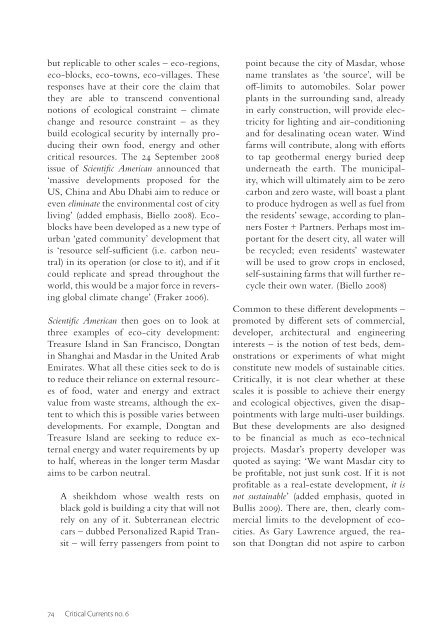Contours of Climate Justice - Dag Hammarskjöld Foundation
Contours of Climate Justice - Dag Hammarskjöld Foundation
Contours of Climate Justice - Dag Hammarskjöld Foundation
You also want an ePaper? Increase the reach of your titles
YUMPU automatically turns print PDFs into web optimized ePapers that Google loves.
ut replicable to other scales – eco-regions,<br />
eco-blocks, eco-towns, eco-villages. These<br />
responses have at their core the claim that<br />
they are able to transcend conventional<br />
notions <strong>of</strong> ecological constraint – climate<br />
change and resource constraint – as they<br />
build ecological security by internally producing<br />
their own food, energy and other<br />
critical resources. The 24 September 2008<br />
issue <strong>of</strong> Scientifi c American announced that<br />
‘massive developments proposed for the<br />
US, China and Abu Dhabi aim to reduce or<br />
even eliminate the environmental cost <strong>of</strong> city<br />
living’ (added emphasis, Biello 2008). Ecoblocks<br />
have been developed as a new type <strong>of</strong><br />
urban ‘gated community’ development that<br />
is ‘resource self-suffi cient (i.e. carbon neutral)<br />
in its operation (or close to it), and if it<br />
could replicate and spread throughout the<br />
world, this would be a major force in reversing<br />
global climate change’ (Fraker 2006).<br />
Scientifi c American then goes on to look at<br />
three examples <strong>of</strong> eco-city development:<br />
Treasure Island in San Francisco, Dongtan<br />
in Shanghai and Masdar in the United Arab<br />
Emirates. What all these cities seek to do is<br />
to reduce their reliance on external resources<br />
<strong>of</strong> food, water and energy and extract<br />
value from waste streams, although the extent<br />
to which this is possible varies between<br />
developments. For example, Dongtan and<br />
Treasure Island are seeking to reduce external<br />
energy and water requirements by up<br />
to half, whereas in the longer term Masdar<br />
aims to be carbon neutral.<br />
A sheikhdom whose wealth rests on<br />
black gold is building a city that will not<br />
rely on any <strong>of</strong> it. Subterranean electric<br />
cars – dubbed Personalized Rapid Transit<br />
– will ferry passengers from point to<br />
74 Critical Currents no. 6<br />
point because the city <strong>of</strong> Masdar, whose<br />
name translates as ‘the source’, will be<br />
<strong>of</strong>f -limits to automobiles. Solar power<br />
plants in the surrounding sand, already<br />
in early construction, will provide electricity<br />
for lighting and air-conditioning<br />
and for desalinating ocean water. Wind<br />
farms will contribute, along with eff orts<br />
to tap geothermal energy buried deep<br />
underneath the earth. The municipality,<br />
which will ultimately aim to be zero<br />
carbon and zero waste, will boast a plant<br />
to produce hydrogen as well as fuel from<br />
the residents’ sewage, according to planners<br />
Foster + Partners. Perhaps most important<br />
for the desert city, all water will<br />
be recycled; even residents’ wastewater<br />
will be used to grow crops in enclosed,<br />
self-sustaining farms that will further recycle<br />
their own water. (Biello 2008)<br />
Common to these diff erent developments –<br />
promoted by diff erent sets <strong>of</strong> commercial,<br />
developer, architectural and engineering<br />
interests – is the notion <strong>of</strong> test beds, demonstrations<br />
or experiments <strong>of</strong> what might<br />
constitute new models <strong>of</strong> sustainable cities.<br />
Critically, it is not clear whether at these<br />
scales it is possible to achieve their energy<br />
and ecological objectives, given the disappointments<br />
with large multi-user buildings.<br />
But these developments are also designed<br />
to be fi nancial as much as eco-technical<br />
projects. Masdar’s property developer was<br />
quoted as saying: ‘We want Masdar city to<br />
be pr<strong>of</strong>i table, not just sunk cost. If it is not<br />
pr<strong>of</strong>i table as a real-estate development, it is<br />
not sustainable’ (added emphasis, quoted in<br />
Bullis 2009). There are, then, clearly commercial<br />
limits to the development <strong>of</strong> ecocities.<br />
As Gary Lawrence argued, the reason<br />
that Dongtan did not aspire to carbon
















